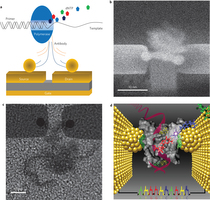
Nanopore Sequencing by Divine Intervention?
It is not clear why nanopore technology, among all sequencing approaches, creates so much controversies. Oxford Nanopore has been ‘unveiling’ their ultra-low cost USB stick sequencer since 2011 -
Jan 2011: Cluster Sequencing with Oxford Nanopores GridION System
Feb 2012: Making sequencing simpler with nanopores
Sep 2012: Benchtop sequencers ship off
Nov 2012: Oxford Nanopore to Unveil New DNA Sequencers This Week
Mar 2013: MinION: A complete DNA sequencer on a USB stick

but there is only one problem. They did not send any data to Mike the mad biologist (
Dear Oxford Nanopore: How About Some Data?) or other less mad ones for that matter.
-—————————————————
In contrast, the latest nanopore controversy is about a new paper that presented plenty of data, but the data looks so good that others are wondering whether researchers had help from God. If not, their paper would be worthy of Nobel-prizes from all branches of science. Strangely none of those critical break-throughs are described in the paper. (h/t: @infoecho)
The authors built a protein transistor working at superconducting temperature and passed the DNA molecule through it. Supposedly, the gate voltage modulated with DNA polymerase incorporating additional nucleotides and caused nucleotide-specific spikes in current between drain and source.

The claims were questions by everyone including physicists, chemists and biologist. However, one group did not find them to be exaggerated (see at the bottom).
Industry Experts Question Claims of Sequencing Study Published in Nature Nanotechnology
The group questioning the paper has issues with components of the physics,
enzymology and chemistry behind the study.
One issue, said Lindsay, is that the study describes using superconducting materials
at the interface of the protein transistor and probes to reduce signal decay.
However, he said, “none of us know of a superconducting material that works at the
same temperature as a polymerase.”
Superconducting materials operate at well below freezing with even so-called high
temperature superconductors operating below -135 degrees Celsius. Polymerases, on
the other hand, generally operate around room temperature
Another issue relates to the bioelectronics and chemistry. The study’s authors say
that they applied a voltage across the electrodes of up to 9.0 volts. However, at
that high of a voltage, water would become hydrolyzed, generating hydrogen and
oxygen gases. If that happened, said Wanunu, it would be difficult to measure
signals that were a property of the enzyme.
In order to not hydrolyze water, he said the applied voltage would have to be below
around 1.5 volts.
Finally, the scientists had concerns with the enzymology described in the paper.
Which group of ‘scientists’ did not question the paper? Economists of course, for whom exaggeration is standard operating procedure :)